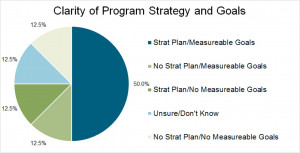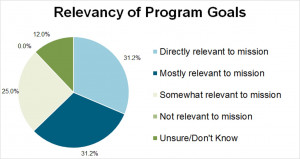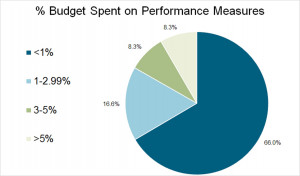Beginning January 20, 2017, Donald Trump will be at the helm. He is a business man focused on the bottom line. He will expect agencies to set clear goals that align with his administration’s priorities. For most goals, he will expect to see hard numbers to gauge performance. Program adjustments will be based on those numbers.

A significant number of program-level staff operate without a formal strategic plan and/or measureable goals, according to the OPP/PMI Study.
In September 2016, the Project Management Institute (PMI) and Outreach Process Partners, LLC (OPP) conducted interviews with experienced program-level staff across six federal agencies to better understand how agencies develop strategies and goals to achieve their mission. We also explored how agencies measure performance.
Based on the OPP/PMI study findings, only 50% of programs have both a formal strategic plan and associated measurable goals that are tracked against the plan.
37.5% of program-level federal employees interviewed do not have measurable goals or, if they do, these goals have not being communicated to them.
Our findings are consistent with GovLoop’s survey of more than 400 of its community members where 39% reported either not using data analytics or unsure.

For programs that collect data for performance measures, the data’s relevancy the agency’s mission may not be aligned.
Our study further highlights a potential issue of data relevancy. 37% noted that the data collected for performance measures was only “somewhat relevant” or “unsure/not relevant” to their agency’s mission.
Just doing a good job day-after-day won’t be enough anymore. Federal program-level staff must work with agency leadership to demonstrate and document the value that their program brings to our nation. In particular, agencies must show how their program-level efforts help fulfill Whitehouse and agency-level priorities and goals.
But let’s not slam beleaguered federal agencies too hard. It is a universal challenge.
According to PMI’s 2016 Pulse of the Profession®, organizations across all industries waste $122 million for every $1 billion spent due to poor project performance – a 12 % increase over last year. If it were easy, everyone would be marching to clear goals set by their executives. All organizations would achieve positive measurable outcomes for every initiative that are on-time and on-budget.

Two-thirds of participants noted that less than 1% of their budget is spent on monitoring and measuring performance. If effective program performance is truly a priority, additional investment will be needed.
And budgets are a factor. Our study found that for 66% of participants, the percent of budget spent on performance tracking and measurement is less than 1% of the total program budget.
So let’s give kudos to the portion of these programs that still managed to collect and document performance on such a shoestring.
With Trump’s business background, setting clear goals and measuring performance against those goals will be expected. Let’s hope it will be funded as well.
See full OPP/PMI performance measures study results and let us know what you think.





Leave a Reply
You must be logged in to post a comment.